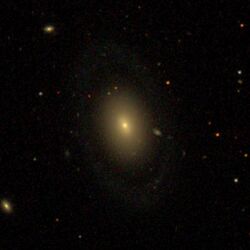Astronomy:NGC 4513
| NGC 4513 | |
|---|---|
 SDSS image of NGC 4513. | |
| Observation data (J2000 epoch) | |
| Constellation | Draco |
| Right ascension | 12h 32m 01.5s[1] |
| Declination | 66° 19′ 57″[1] |
| Redshift | 0.007685[1] |
| Helio radial velocity | 2304 km/s[1] |
| Distance | 110 Mly (33 Mpc)[1] |
| Group or cluster | NGC 4256 Group |
| Apparent magnitude (V) | 13.7[1] |
| Characteristics | |
| Type | (R)SA0^0[1] |
| Size | ~55,000 ly (17 kpc) (estimated)[1] |
| Apparent size (V) | 1.21 x 0.88[1] |
| Other designations | |
| CGCG 315-42, MCG 11-15-59, PGC 41527, UGC 7683[1] | |
NGC 4513 is a lenticular galaxy[2][3][4] and a ring galaxy[4][5][3] located about 110 million light-years away[2][3] in the constellation Draco. It was discovered by astronomer Heinrich d'Arrest on October 16, 1866.[6]
Physical characteristics
NGC 4513 has a large and very faint ring[7] that is quite separated from the main galactic disk.[8] The disk is gaseous and counter-rotates with respect to the inner disc. The outer part of the inner disc exhibits a population of counter-rotating stars that may be related to the outer ring.[8][3] The observed counter-rotation suggests that the ring resulted from the accretion of gas from the passage of another galaxy.[3] However, Ilyina et al. proposed that the ring is the result of a satellite galaxy vertically impacting onto the central part of NGC 4513 as the ring is bright in UV and is symmetric.[4]
Group Membership
NGC 4513 is a member of the NGC 4256 Group[9] which lies in the upper plane of the Virgo Supercluster.[10]
See also
References
- ↑ 1.0 1.1 1.2 1.3 1.4 1.5 1.6 1.7 1.8 1.9 "NASA/IPAC Extragalactic Database". Results for NGC 4513. http://nedwww.ipac.caltech.edu/.
- ↑ 2.0 2.1 "Your NED Search Results". https://ned.ipac.caltech.edu/cgi-bin/objsearch?objname=NGC+4513&extend=no&hconst=73&omegam=0.27&omegav=0.73&corr_z=1&out_csys=Equatorial&out_equinox=J2000.0&obj_sort=RA+or+Longitude&of=pre_text&zv_breaker=30000.0&list_limit=5&img_stamp=YES.
- ↑ 3.0 3.1 3.2 3.3 3.4 Ilyina, M. A.; Sil'chenko, O. K.; Afanasiev, V. L. (2014-03-01). "Nature of star-forming rings in S0 galaxies". Monthly Notices of the Royal Astronomical Society 439 (1): 334–341. doi:10.1093/mnras/stt2441. ISSN 0035-8711. Bibcode: 2014MNRAS.439..334I.
- ↑ 4.0 4.1 4.2 Sil'chenko, Olga K.; Ilyina, Marina A. (2011-05-16) (in en). Lenticular galaxies with UV-rings. doi:10.1134/S0320010811090051.
- ↑ Moss, D.; Mikhailov, E.; Silchenko, O.; Sokoloff, D.; Horellou, C.; Beck, R. (August 2016). "Magnetic fields in ring galaxies". Astronomy & Astrophysics 592: A44. doi:10.1051/0004-6361/201628346. ISSN 0004-6361. Bibcode: 2016A&A...592A..44M.
- ↑ "New General Catalog Objects: NGC 4500 - 4549". https://cseligman.com/text/atlas/ngc45.htm#4513.
- ↑ Buta, R. J. (November 2017). "Galactic Rings Revisited. I. CVRHS Classifications of 3962 Ringed Galaxies from the Galaxy Zoo 2 Database". Monthly Notices of the Royal Astronomical Society 471 (4): 4027–4046. doi:10.1093/mnras/stx1829. ISSN 0035-8711. Bibcode: 2017MNRAS.471.4027B.
- ↑ 8.0 8.1 Silchenko, O.; Ilyina, M.; Katkov, I. (2014). "Outer rings in early-type galaxies: from Vorontsov-Velyaminov to present". Baltic Astronomy 23 (3–4): 279–285. doi:10.1515/astro-2017-0192. ISSN 1021-6766. Bibcode: 2014BaltA..23..279S.
- ↑ Garcia, A. M. (1993-07-01). "General study of group membership. II - Determination of nearby groups". Astronomy and Astrophysics Supplement Series 100: 47–90. ISSN 0365-0138. Bibcode: 1993A&AS..100...47G.
- ↑ Fouque, P.; Gourgoulhon, E.; Chamaraux, P.; Paturel, G. (1992-05-01). "Groups of galaxies within 80 Mpc. II - The catalogue of groups and group members". Astronomy and Astrophysics Supplement Series 93: 211–233. ISSN 0365-0138. Bibcode: 1992A&AS...93..211F.
External links
- NGC 4513 on WikiSky: DSS2, SDSS, GALEX, IRAS, Hydrogen α, X-Ray, Astrophoto, Sky Map, Articles and images
 |

